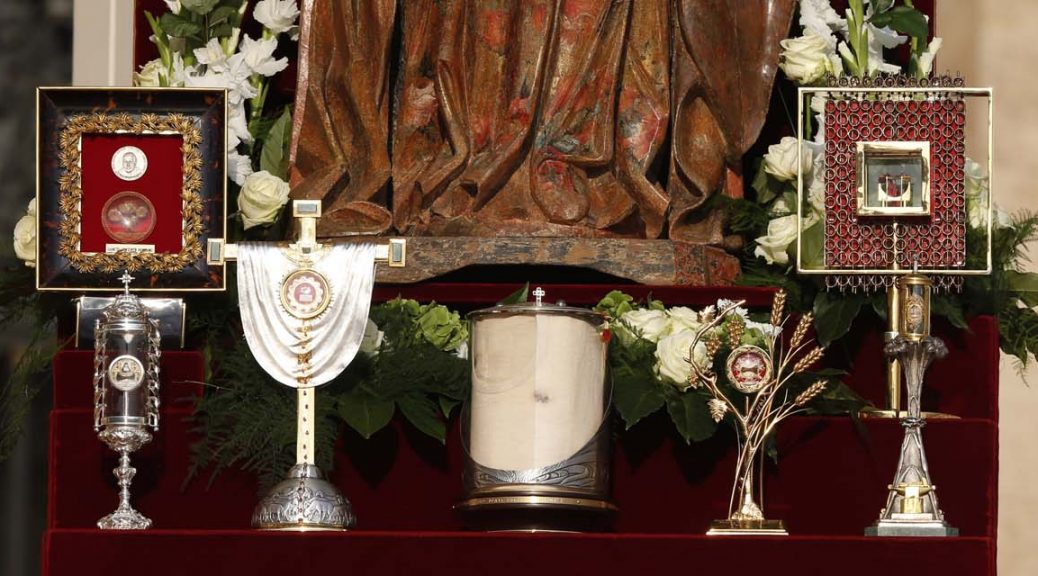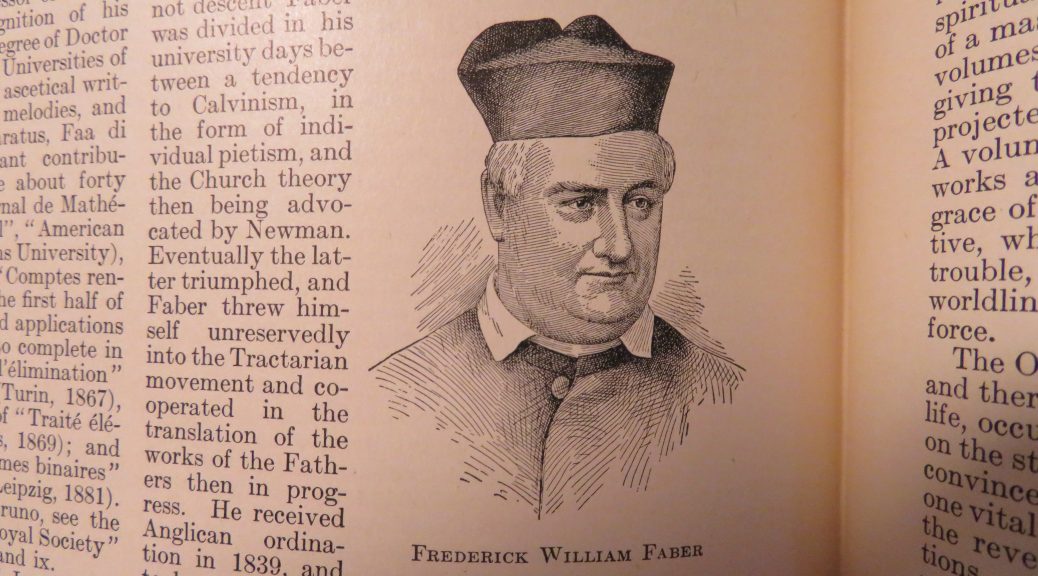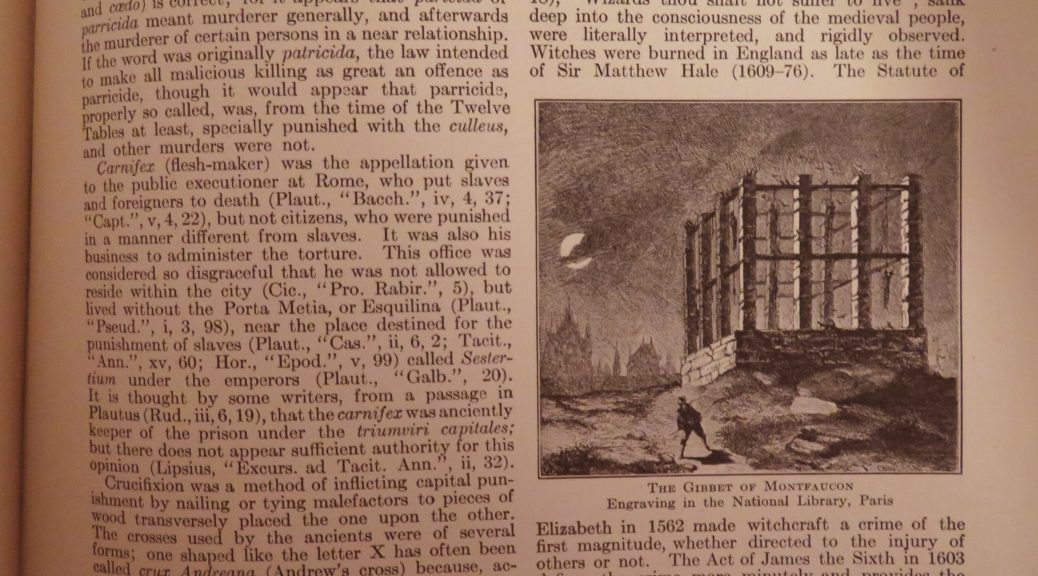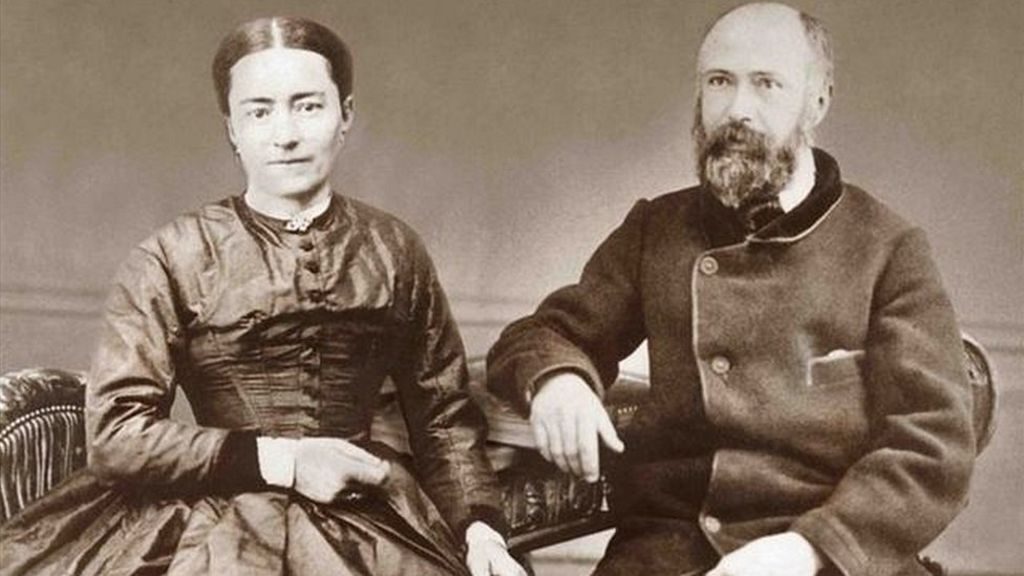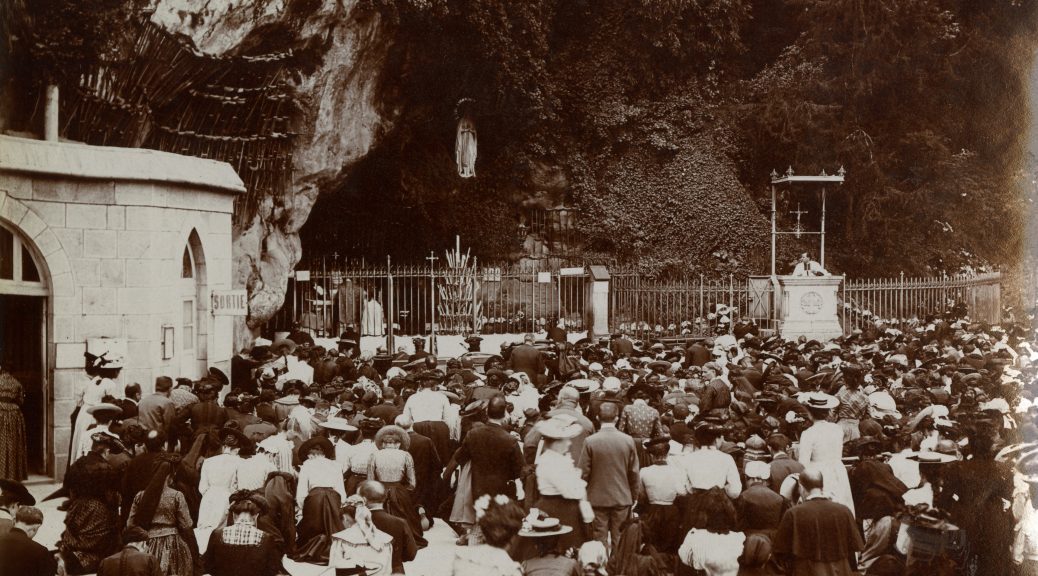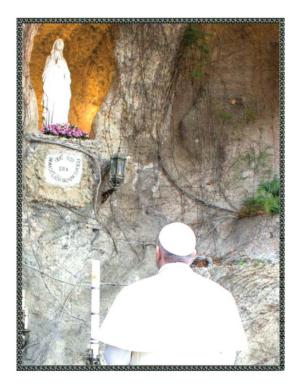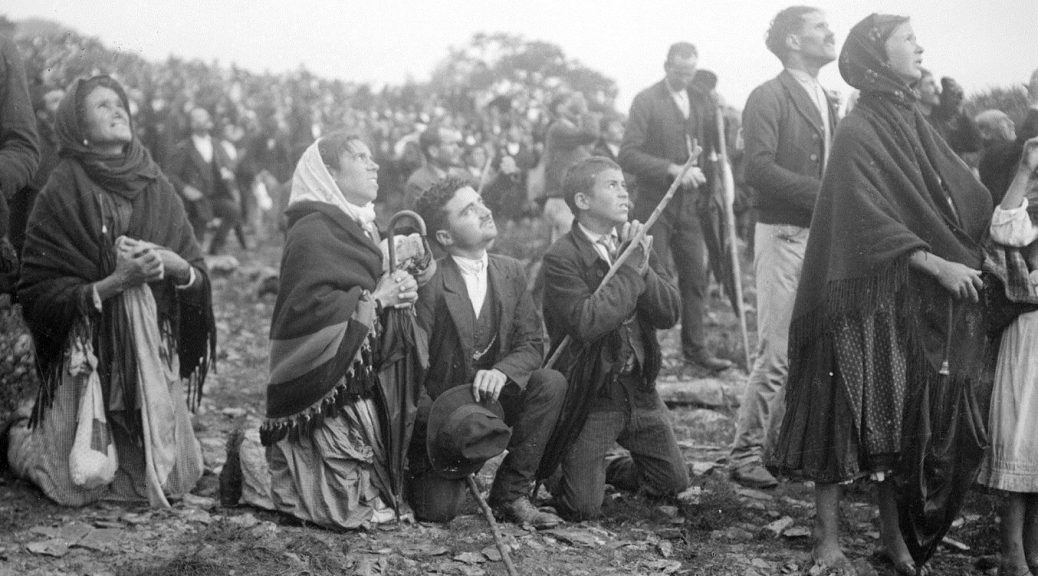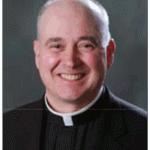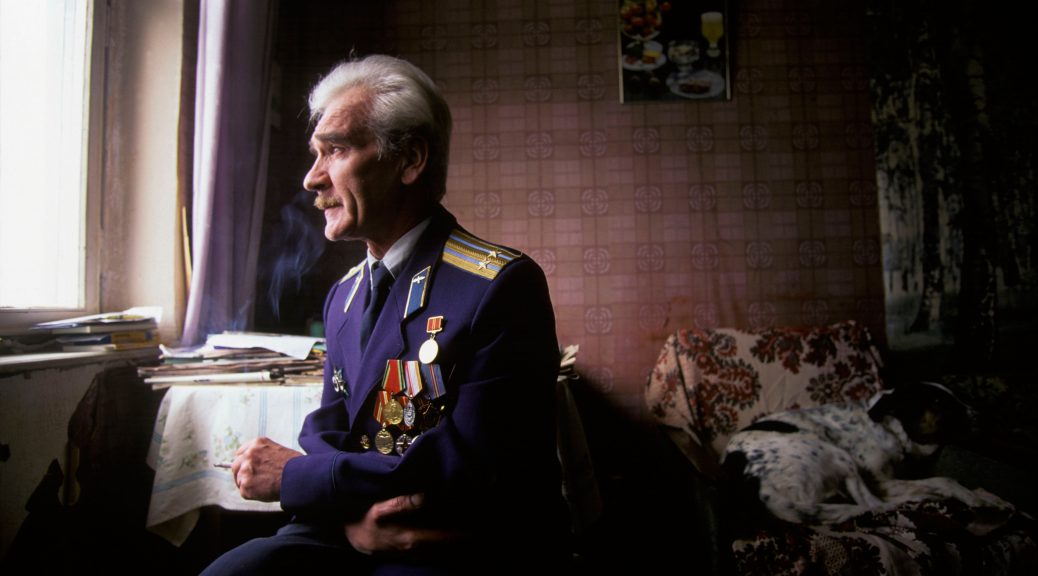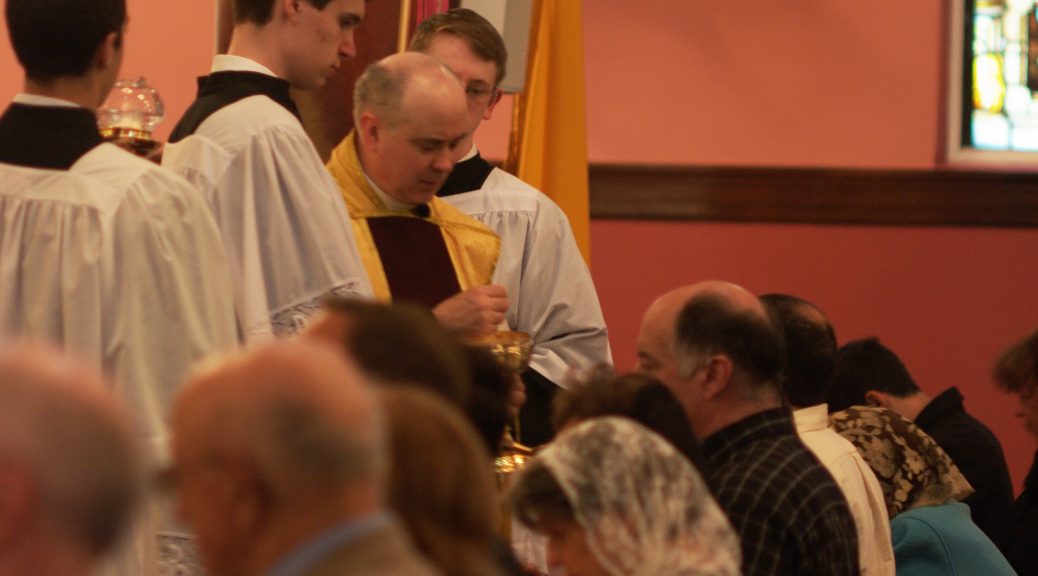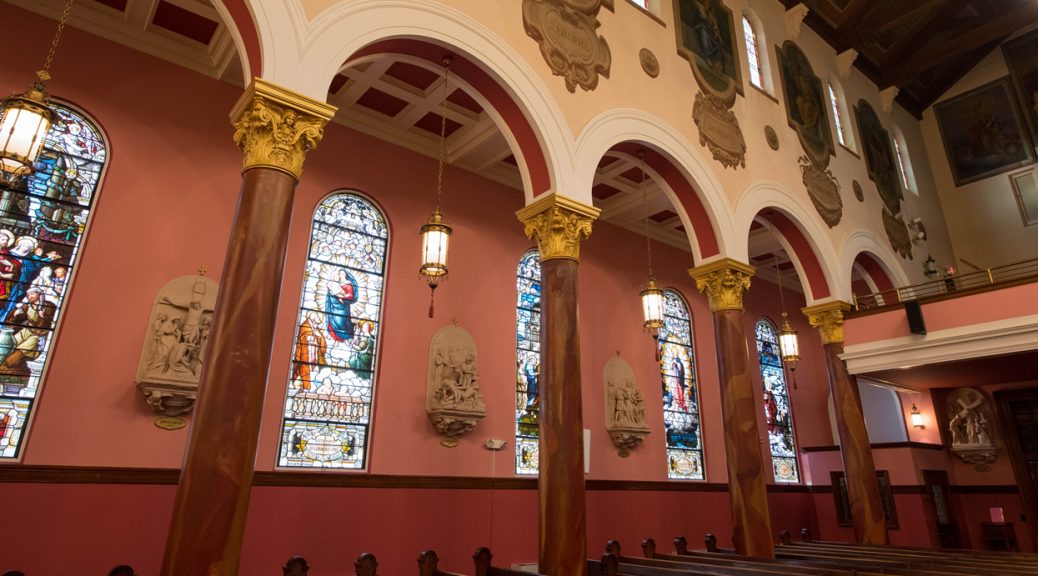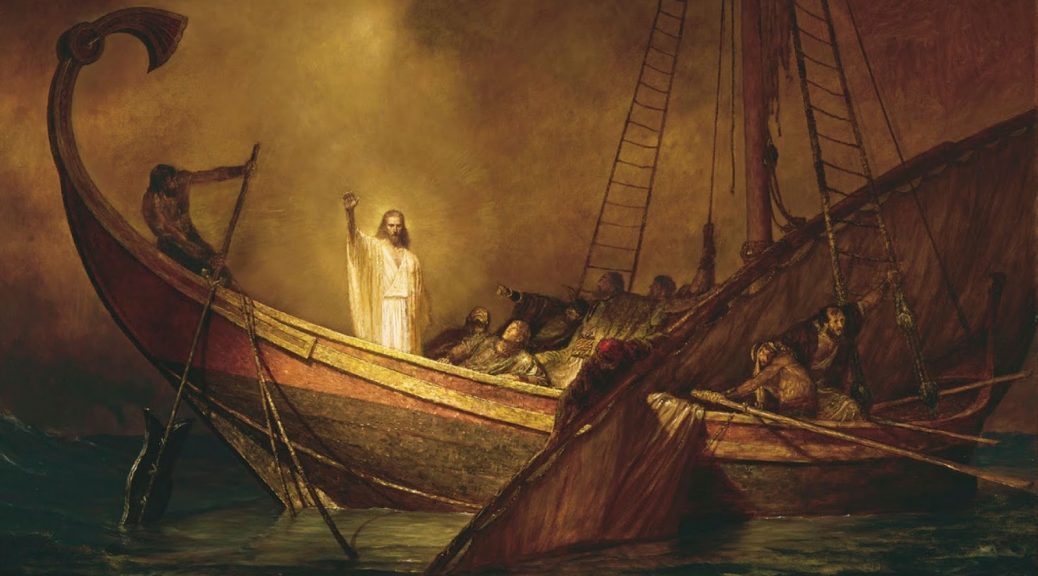
Latest Parish Bulletin
The Miracle of the Sun at Fatima, 100 Years Ago
October the 13th this year marked the 100th Anniversary of the great sign of the Miracle of the Sun at Fatima, Portugal. I have used for our Bulletin front cover this striking picture, reproduced in The Latin Mass Magazine, of the people awestruck by what they are seeing in the sky above.
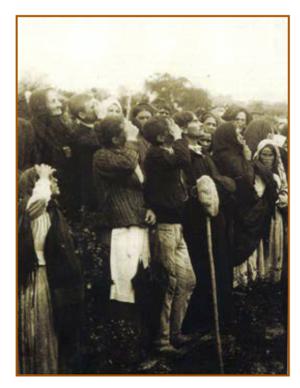
In the July 13th Apparition Our Lady had told the children: “In October…I will work a miracle so that all will see and believe.” In expectation of this promised miracle tens of thousands of people went to the Cova da Iria beginning on October 12th—people of all kinds, good and bad, believers and unbelievers. The crowd estimate was 70,000 people. A soaking rain continued all through the night and until 12 Noon solar time on the 13th when Our Lady appeared to the three shepherd children as she had promised. At the end of the Apparition all of the people began to experience the sun changing its appearance in the sky.
Here is the description of Avelino de Almeida, Editor in Chief of O Seculo, the liberal and anti-clerical daily newspaper of Lisbon, who witnessed the event:
“One could see the immense multitude turn towards the sun, which appeared at its zenith, coming out of the clouds. It resembles a dull silver disc, and it is possible to fix one’s eyes on it without the least damage to the eye. It does not burn the eyes. It does not blind them. One might say that an eclipse was taking place. An immense clamor bursts out, and those who are nearer to the crowd hear a shout: ‘Miracle! Miracle! Prodigy!… Prodigy!…”
“The attitude of the people takes us back to biblical times. Stupefied and with heads uncovered, they watch the blue sky. Before their dazzled eyes the sun trembled, the sun made unusual and brusque movements, defying all the laws of the cosmos, and according to the typical expression of the peasants, ‘the sun danced…’ What did I see at Fatima that was even stranger? The rain, at an hour announced in advance, ceased falling; the thick mass of clouds dissolved; and the sun—a dull silver disc—came into view at its zenith, and began to dance in a violent and convulsive movement, which a great number of witnesses compared to a serpentine dance, because the colors taken on by the surface of the sun were so beautiful and gleaming.”
“Miracle, as the people shouted? A natural phenomenon, as the learned would say? For the moment I do not trouble myself with finding out, but only with affirming what I saw…The rest is a matter between Science and the Church.” (Quoted in The Whole Truth About Fatima: Science and the Facts, by Frère Michel de la Sainte Trinité, Immaculate Heart Publications, English translation edition, 1989.)
In his Pastoral Letter authorizing the cultus of Our Lady of Fatima (October 13th, 1930), the diocesan Bishop José Alves Correia da Silva cited this great sign of the public miracle as a motive for believing in the supernatural character of the Fatima Apparitions.
“The solar phenomenon of the 13th of October, 1917, described in the papers at the time, was something marvelous and caused a great impression upon those who had the happiness to witness it…This phenomenon which no observatory has registered, and therefore, was not a natural one, was observed by persons of all ranks and social classes, believers and unbelievers, journalists of the principal Portuguese dailies and even by persons kilometers away, all of which eliminates the idea that it was a collective illusion.” (quoted from The Latin Mass, Fall 2017, p. 80)
Pastor’s Note from the Mary Immaculate of Lourdes Bulletin for October 29, 2017
Prayer for Peace and the Fatima Message
Last month an obituary appeared in the New York Times for a retired colonel of the Soviet Air Defense Forces, Stanislav Petrov (“Stanislav Petrov, 77; Soviet Who Helped Avert a Nuclear War”). Early on the morning of September 26th, 1983, Lt. Col. Petrov, 44 years old, was a few hours into his shift as the duty officer at Serpukhov-15, the secret command center where the Soviet Union monitored its early-warning satellites over the U.S., when the alarms went off. The computers were telling them that the U.S. had launched 5 Minuteman Inter-Continental Ballistic Missiles against the U.S.S.R.
At that moment the Cold War between the USA and Soviet Russia was worsening. Only three weeks before the Soviets had shot down a Korean Airlines passenger plane which had strayed into its airspace. (One of our parishioners from Mary Immaculate of Lourdes was on that plane: Mrs. Hiroko Ikeda Stevens. William Stevens Jr. and Hiroko Ikeda had been married at Mary Immaculate of Lourdes Church on January 1st, 1983. Her bereaved husband built a peace garden in her memory which is preserved at our parish cemetery of St. Mary’s.)
When the alarms went off then on that September morning it was not at all implausible that the USA had decided to strike in a surprise attack. As the duty officer, it was Lt. Col. Petrov’s role to make the call to his superiors and thereby set the chain of events in motion for a Soviet retaliatory strike.
Years later, in an interview with the BBC, the retired Soviet officer described what had happened:
“There was no rule about how long we were allowed to think before we reported a strike. But we knew that every second of procrastination took away valuable time, that the Soviet Union’s military and political leadership needed to be informed without delay. All I had to do was to reach for the phone; to raise the direct line to our top commanders—but I couldn’t move. I felt like I was sitting on a hot frying pan.” (NYTimes, ibid.)
He ended up making the decision that it was a system malfunction and reported it as such. Indeed it was a false alarm: as it was later determined, the satellite mistook the sun’s reflection off the top of the clouds for a U.S. missile launch. Any believer in God would have to say that it was a special moment of grace that touched this man at just the right moment and he responded to it.
We are only now beginning to learn about the extent of the “near-misses” in the triggering of a nuclear war over the last 72 years. Zbiegnew Brzezinski, who was President Carter’s National Security Adviser, has described his own experience where he had to decide whether a report that nuclear missiles had been launched by the Soviet Union against us was real. It was in the middle of the night. He was poised make the call to the President. But then, like Lt. Col. Petrov, he held-off, making the gut-decision that it was not a real strike.
Former Secretary of State George Schulz, now 96, has recently expressed his concern over the “careless talk” about using nuclear weapons in today’s climate. He used the term “broken arrows” to characterize the false-alarms over nuclear weapons which could have tripped their use, and he indicated their number has not been rare to date.
A crucial part of Our Lady’s message at Fatima 100 years ago was a call for the Prayer for Peace in the face of the threat of annihilating warfare. Catholics, are we praying hard enough?
Pastor’s Note from the Mary Immaculate of Lourdes Bulletin for October 22, 2017
Pastor’s Note Update
I have added Father’s “Pastor’s Note” from the March 23, 2014 bulletin:
The “featured image” is a detail from Triumph of St Thomas Aquinas by Benozzo Gozzoli (1471). Tempera on panel, 230 x 102 cm — Musée du Louvre, Paris
Pastor’s Note Update
I have added Father’s “Pastor’s Note” from the June 30, 2013 bulletin:
Silver Jubilee of Ordination: An Occasion of Grateful Thanks
The “featured image” is Madonna at Prayer by Giovanni Battista Salvi, called Sassoferrato (1609-1685, Rome). Oil on canvas.
Pastor’s Note Update
I have added Father’s “Pastor’s Note” from the October 14, 2012 bulletin:
Preaching the Word out of Season
The featured image is a detail from Scene number 3 of a series of 19 depicting the life of St. Francis by Benozzo Gozzoli. More information about, and pictures of, these frescoes is available here.
Pastor’s Note Update
I have added Father’s “Pastor’s Note” from the August 20, 2017 bulletin:
The Altar Rail: Our Place at the Lord’s Table
The “featured image” is communion at Mary Immaculate on June 5, 2011.
The Altar Rail: Our Place at the Lord’s Table
First, my childhood memories of receiving Holy Communion at the altar rail: I received my First Holy Communion in May of 1969 at St. Joseph’s Church in Needham. I was eight years old. The parish School Sisters, the Sisters of Charity of Halifax, were in charge of our catechism.
I remember well the instruction we were given on how to take Communion. You were to take your place kneeling at the altar rail and not look down the rail to see where the priest was. Instead you were to pray and to think about how you were going to receive Jesus. When you heard the priest about to come to you, you closed your eyes, held your head slightly back, and opened your mouth wide enough so that the priest could place the Host on your tongue. After you received it was important for you not to move until the person next to you had also received, so as not to disturb their Communion. Then you could go back to your pew, kneel down, and continue making your Thanksgiving. It was a wonderful rite of passage for a Catholic child.
Several years later, the mid-1970’s, St. Joseph’s as with many other parishes stopped using the altar rail for Communion. We started queuing up in lines to receive Communion standing. I remember how jarring it felt. Vague explanations were given to us about the changes being in keeping with Vatican II. One such justification offered was: “We are a ‘Pilgrim People’ and so we should be standing to receive Communion.”
When I got to the Seminary in 1983 I heard the altar rail spoken of in one-sidedly negative terms as a barrier between the people and the sanctuary. This was not how I remembered it nor did it take into account the good feelings I associated with Communion at the rail.
We restored the altar rail here at Mary Immaculate of Lourdes parish in 2010. This was part of the mandate I was given by Cardinal Sean: to put in an altar rail to accommodate the Traditional Latin Mass Community coming over from the Holy Trinity German Church in Boston.
I would like to offer here a more positive understanding of the place of the altar rail than the characterizations of it as a barrier or an oldfashioned practice which has no use in today’s Church outside of Traditional Mass communities. That is the understanding of the altar rail as our place at the Lord’s Table.
In the offering of Mass upon the altar there is a movement from the Sacrifice of the Cross to the Mystical Banquet of Christ the Lamb of God. At the time of Communion the Altar of Sacrifice is now transformed into this heavenly Table of the Lord. The altar rail represents the extension of the Banquet Table to where the people come in order to receive their Eucharistic Lord. To kneel or stand at that altar rail is to take your place at the Lamb’s High Feast (“Blessed are those who are called to the Supper of the Lord!”) At the altar rail, as at a banquet table, you have other guests beside you, re-enforcing the communitarian aspects of Christianity.
It is a visually and physically striking enactment of the beautiful words of the Lord’s coming in St. John’s Apocalypse: “Behold, I stand at the gate and knock. If any man shall hear My voice and open to Me the door, I will come in to him and will sup with him: and he with Me.” (Apoc. 3:20)
Pastor’s Note from the Mary Immaculate of Lourdes Bulletin for August 20, 2017
New Parish Website
Please be sure to visit the new Mary Immaculate of Lourdes Parish website at maryimmaculateoflourdes.org
Stained Glass information is here with a complete gallery of the windows here.
Many thanks to all concerned for this beautiful new parish website!
A Month of “Respect for Life”
(Pastor’s Note from the Mary Immaculate of Lourdes Parish Bulletin for October 2, 2016)
In the United States each year the Month of October is designated as the particular month of the year in which we ought, as Catholics, to focus on the “Life Issues”. Our Christian Catholic faith and our supernatural view of things enable us to recognize human life as a great good, possessing an essential value which nothing can take away.
This essential value of human life applies to each individual human life as well as to humanity as a whole. Human life cannot be reduced or downgraded to its practical utility. There is no such thing as “life unworthy of life”, as the advocates of euthanasia and sterilization of the disabled in the early 20th century claimed.
Each human being, possessing an immortal soul, is a unique, special creation of God and infinitely loved by Him. Every person should be helped to understand this about himself: you are a unique, special creation of God and infinitely loved by Him. You are not a “mistake”. Your essential value does not depend on the circumstances of your origins. You do not lose your value by becoming a “burden” on others.
Yes, we come to this conclusion on the absolute value of each human life as a matter of Christian faith-belief. But that is nothing to apologize for! Its truth is still engraved in every heart, and if we are faithful in bearing witness to it in the “public square”—and do it in the manner of the charity of Christ—then others will recognize it too.
It was Pope John Paul II who framed the contemporary debate in terms of the “Culture of Life” versus the “Culture of Death”. This is an inspired juxtaposition. We can easily be distracted in policy debates by the utilitarian arguments (e.g., having too many disabled people in society is a drain on public resources), or the anti-human philosophical ideas which abound (e.g., in order to preserve the eco-system of the planet, the human presence on the earth must be drastically reduced).
Stewardship of the earth and the organization of society with a just allocation of goods are indeed part of the challenge in building up a Culture of Life, but their claims cannot be allowed to supersede the intrinsic value of each and every human life.
During this Month of October, both from the pulpit and in my Pastor’s Note, I will be emphasizing the “Life Issues”. There is so much “Culture Smog” that it is easy for us to become numbed to what is at stake. The whole spectrum of the Life Issues is vast but I will enumerate some:
- The manipulation of human life at its origins.
- Abortion of unborn children.
- Disability.
- Euthanasia: the deliberate killing of the disabled and the mortally ill before they are naturally dying.
- The Primary Duty of keeping oneself alive.
- Suicide.
- Acceptance of natural death.
We come from God and we are going back to God over the course of this brief life’s journey. Let us not fail to recognize the great dignity we have as special creations of God the Heavenly Father.
“The greatest destroyer of peace today is abortion, because it is a war against the child, a direct killing of the innocent child, murder by the mother herself. And if we accept that a mother can kill even her own child, how can we tell other people not to kill one another? Any country that accepts abortion is not teaching its people to love, but to use any violence to get what they want. This is why the greatest destroyer of love and peace is abortion.”
—Mother Teresa of Calcutta
